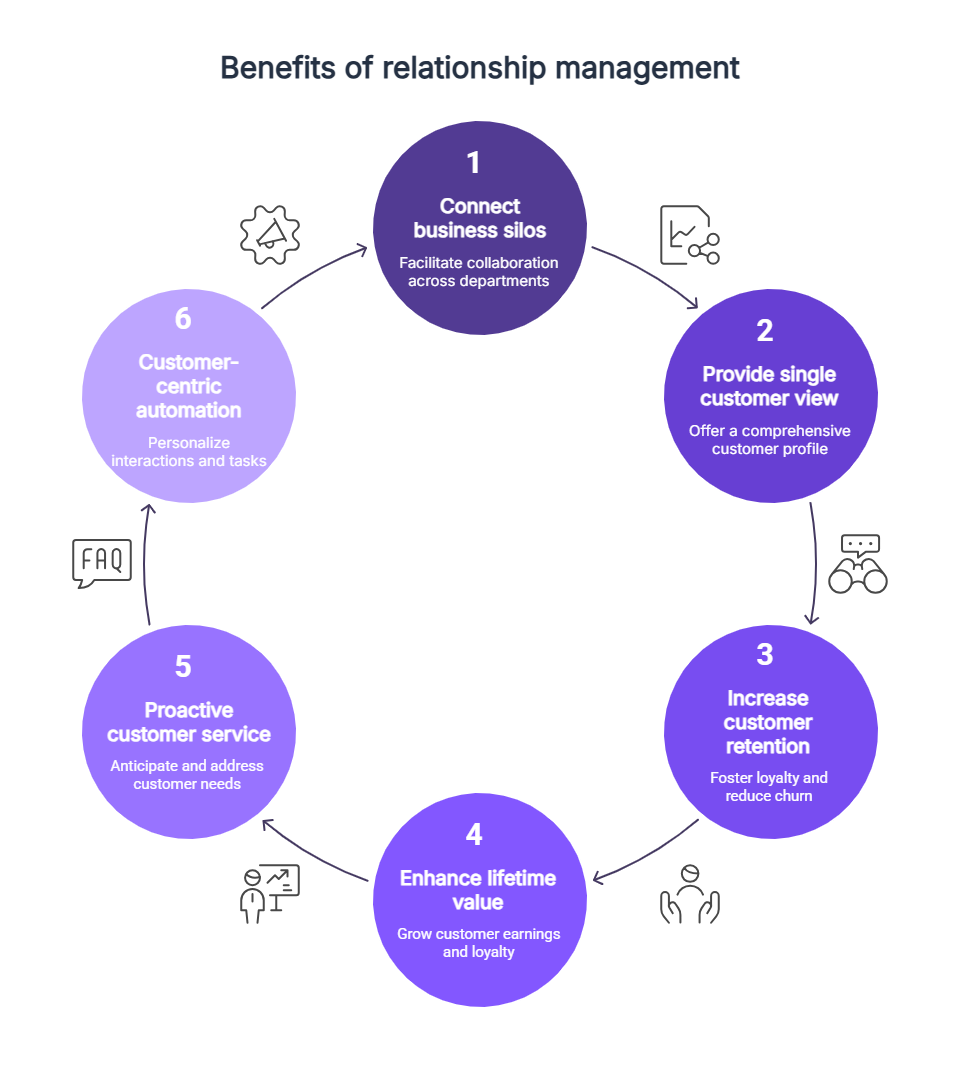Relationship management that turns buyers into partners

A retailer chooses a vendor based on promises, but poor service costs them trust. Another stepped up with empathy and action. That’s the power of relationship management. Want loyal customers and long-term growth? Start building positive relationships today.
Highlights
You’ll learn about the benefits of relationship management:
- Builds customer trust through empathy and proactive support
- Improves retention by addressing issues before they escalate
- Enhances loyalty with personalized, human interactions
- Increases revenue via long-term engagement and referrals
Don't just sell—build lasting relationships.
A mid-sized online retailer wanted a content management system (CMS) to unify its digital experience across multiple regions. After checking out several suppliers, it liked Platform X for its advanced features and ease of use. Custom enterprise features were not included in the currently available product.
According to the sales team, Platform X was working on adding these features, which would come out in the next quarter. After reading the roadmap and hearing the representative’s words, the company agreed to stop looking elsewhere and stay patient.
Three months later, the customer reached out to see about the promised features. The release of the new version came before, yet the customer couldn’t find or use the key features he wanted. When they raised the issue, the representative neglected to look at what had happened earlier, did not apologize and paid little attention to settling the matter. The customer was unhappy and unsatisfied.
They contacted a different platform provider called Platform Y, but the platform lacked certain features. Rather than allowing the customer to leave, their team presented a special solution. A combined session was held with product and engineering to learn exactly what the company needed, provide a temporary solution and plan a schedule for building and deploying the required feature. The agency informed the company and assigned a project manager to help reach its targets.
If you were this e-commerce company, which vendor would you prefer to work with?
Platform Y earned trust by offering a product, but by building a relationship. That’s the power of relationship management. It converts vendors into long-term partners. For software providers, service firms and product companies alike, investing in customer relationships isn’t optional. It’s essential for retention, reputation and revenue growth.
Let’s explore what successful relationship management is and the key parts of customer relationships.
What is relationship management?
Relationship management refers to the process of building relationships with customers. Various customer relationship strategies and tools are used in the process. When you know what your customers like, how they shop and what they need, you can give them the right support quicker and win their loyalty. Good relationship management helps maintain customer loyalty, makes people happy and promotes business growth.
Instead of viewing relationships as purely transactional, relationship management considers every interaction meaningful. Effective relationship management is of two types:
- Business relationship management
- Customer relationship management
Relationship management includes:
- Learning what your customers hope to achieve and shaping your solutions to achieve that
- Keeping communication with customers open and consistent all the time
- Offering assistance before problems become serious and solving them quickly
- Sharing clearly what you can do, when it will be done and what you cannot do
- Focusing on sustainably offering value during and after sales
- Using CDPs to watch how people interact, what they like and what they say
Say goodbye to data silos. Contentstack Real-Time CDP empowers marketers with unified profiles and advanced audience targeting. Deliver tailored, real-time engagements that increase ROI and build customer trust.
The key parts of strong customer relationships
Getting to know your customers better
Before you build valuable customer relationships, get to know them. Understanding these insights comes from analyzing your customers' data. When you check your customers’ purchase records, what they browse and how they use your services, you can discover what is most important to them. Knowledge about your customers helps you predict their actions, modify your marketing, offer personalized solutions and make customers feel appreciated. Personalized offers, emails or onboarding experience can encourage customers to return.
Listening to your customers is equally important. Use surveys, support tickets and comments on social media to know what customers are saying about your brand and how they feel about interacting with it. Responding to customers’ ideas proves you value them and can fulfill their expectations.
Mapping your customer experience
Companies don’t just stumble into a good customer experience. You should make use of a targeted process known as Customer Journey Mapping. It allows you to follow all the customer’s actions, from initial discovery to long-term engagement. As you draw out the path customers take, you can notice when they feel unhappy or misunderstood. You may discover these challenges when someone signs up, makes a purchase or contacts customer service. When you know the issues, you can make changes that help users enjoy the website more.
Mapping the customer’s journey opens up ways to improve communication. When you actively keep customers informed, guide them easily and help at the right moment, you improve your brand image. The aim is to ensure every contact point with customers is positive, regardless of the touchpoint. People who enjoy each interaction with you are more likely to stay loyal to your brand.
Using technology smartly
Real-time CDPs build customer loyalty by merging data collected from several sources and presenting it in a single customer view. Because of this insight, teams in marketing, sales and service can have relevant and personalized interactions. With a customer data platform (CDP), companies can offer similar experiences for customers on all channels, which leads to greater engagement. Thanks to spotting specific behavioral patterns, you can deal with problems before they get out of hand.
Thanks to CDPs, brands can combine data and offer services that strengthen their relationships and attract customer trust.
Don’t let technology interfere with how your customers connect. Even now, many customers look for sincere conversations and a sympathetic ear, primarily when searching for information or making important decisions. By handling mundane work, automation allows your team to spend more time talking and empathizing with customers.
Benefits of relationship management
Connects your business silos
What’s the biggest challenge most organizations face? Their departments work in silos instead of one cohesive unit. The sales team doesn’t talk to marketing, the marketing team doesn’t communicate with support, the support team doesn’t interact with the development team and so on. Relationship management connects these dots. How? When all departments use the same customer data, collaboration becomes much easier.
Example: A customer reaches out to support about an issue they previously discussed with sales. With a connected system, the support agent can instantly see the sales notes and respond with context, saving the customer from repeating themselves and improving their experience.
Provides a single view of customers
What’s more beneficial—customer information scattered everywhere or consolidated at one place? The latter gives your teams a 360-degree view of your customers. You know their likes, dislikes, interactions and behavior. Using this information, it becomes easier to deliver personalized experiences.
Example: A retail company can use a unified view to see that a customer recently purchased workout gear and then send them personalized follow-up offers on fitness accessories or training programs.
Higher customer retention
With companies generating 65% of their business from existing customers who are likely to spend an average of 67% more than new customers, retaining customers in every field makes sense. Building strong relationships increases loyalty and reduces churn. Repeat customers are more than revenue. They’re brand advocates. They leave good reviews, refer others and easily forgive mistakes because they trust you. With relationship management as the backbone of your retention strategy, you’re nurturing a community of loyal users who grow with your business.
Example: A long-time B2B SaaS platform witnesses a sudden decline in customers. With strong relationship management, your team gets an automated alert and reaches out—not with a sales pitch, but with a helpful check-in. Maybe they’re facing a technical issue, or perhaps a team member has left. That timely, human contact could stop them from leaving altogether.
Increases lifetime value
A good relationship management process helps companies offer the right upselling or cross-selling, increasing the lifetime value. Proactive customer involvement and added value keep customers longer. If you observe customer behavior and attitude, you’ll know the right time to offer renewals and expansions, instead of waiting until they have a complaint. Additionally, managing relationships creates loyalty, makes customers shop again and brings in referrals, raising each customer’s earnings for the company.
Example: A company that offers digital marketing services notices that a client who started with social media management is now opening more emails about SEO and PPC. With that data, a relationship manager reaches out with a bundled offering tailored to those interests. Because it’s timely and relevant, the client says yes, adding thousands in annual revenue.

Proactive customer service interactions
Customer service is proactive when you contact customers early, rather than waiting for them to ask for help. Good relationship management helps you recognize customer actions, anticipate what customers may need and act in advance to solve any arising issues. Whether it’s offering help when usage patterns drop, notifying users of potential disruptions or recommending best practices based on their behavior, proactive service builds stronger relationships.
Example: The project management software company notices that a customer’s team has not logged in through the software for a week. Rather than sending a cancellation notice, a success rep emails the customer, inviting them to a quick refresher training or helping them add more users to the platform. That act makes the team feel valued, encourages friendship and reduces the possibility of customers leaving.
Offers customer-centric automation
Relationship management lets you handle everyday customer tasks without forgetting the personal touch. Rather than sending generic mass emails or automated workflows, customer-centric automation bases its actions on fresh data and observes each customer’s actions to deliver right on time and in context. It helps you reach more people, and every customer feels they are truly valued and heard. Sending a greeting email, a thank-you note following a purchase or a rewards message consistently improves customers’ experience and motivates them to keep coming back.
Example: An online skincare brand uses technology to know when a customer has almost finished using a product. With just a personalized email and a reorder link, the customer can quickly restock entirely on their own.
Role of CDP in multichannel relationship management
When customers move across channels—website, mobile app, email, chat, social—businesses need to do more than just keep up. They need to deliver consistent, personalized experiences at every touchpoint. That’s where a Customer Data Platform (CDP) becomes essential.
With a CDP, the customer information from your CRM, marketing tools, support and analytics is gathered and shown as one view in real time. It breaks up any barriers and shares insights with teams that reach out to potential customers, so you use the same message everywhere. But data alone isn’t enough. You need the ability to act on that insight fast.
That’s where the power of a composable architecture comes in. You can personalize content based on customer segments and behaviors when your CDP is integrated with a headless CMS like Contentstack. For example, a returning customer browsing your site might see a different homepage than a first-time visitor. A high-value user could receive a personalized onboarding email or a targeted in-app recommendation instantly.
In this setup, your CDP stores data and provides real-time personalization at scale. Agile content delivery transforms multichannel relationship management from reactive to proactive, from generic to genuinely human.
How does Contentstack improve relationship management?
Here’s how a modern, headless content management system (CMS) builds stronger customer relationships by delivering the right content to the right person at the right time:
Omnichannel content personalization
Contentstack creates modular, reusable content and delivers it across any channel—web, mobile, app, email, chat and more—based on customer behavior and preferences. Whether a customer is browsing on mobile or opening an email, they get an experience that feels personalized and omnichannel.
Real-time integrations with customer data
Contentstack integrates with CDPs, analytics platforms and marketing automation tools. You can feed real-time customer data directly into your content workflows. The result? Personalized experiences that reflect where a customer is in their journey, onboarding, expansion or renewal.
Faster time-to-market with automation and no-code tools
Relationship-building comes down to timing. With Contentstack, marketers and content creators can launch, test and iterate campaigns without relying on developers. Built-in automation and no-code tools let you move quickly and respond in real-time, strengthening customer engagement when it matters most.
Dynamic workflows across teams
Contentstack’s collaborative workflows bring marketing, product, design and development teams together in one place. That means faster approvals, more consistency across touchpoints and fewer bottlenecks that hurt the customer experience.
Elevate your brand with Contentstack's Real-Time CDP! Experience more intelligent marketing with measurable results. Achieve unique omnichannel personalization backed by AI-driven insights, predictive segmentation, and instant updates.
FAQs
What do you mean by relationship management?
Relationship management describes a company's actions to develop friendly connections that last a lifetime—understanding customers’ wishes, creating personal communications and giving good service builds a loyal customer base and helps you expand.
What are the three pillars of relationship management?
While interpretations can vary, three fundamental pillars are often considered:
- People: The skills, training and customer-centric culture of your team. For instance, your team needs relationship management skills for building trust and loyalty.
- Process: The workflows, Customer Journey Mapping and strategies you implement to manage interactions.
- Technology: The tools (like CDPs and CMSs) that enable and support your people and processes in delivering excellent customer service and personalized experiences.
What are the basics of relationship management?
To manage a relationship, you learn what customers want, offer them great value and work on sustaining strong, lasting bonds. It uses communication, data and personalized services to help earn customers’ trust, loyalty and support business growth.
Learn more
Not only do excellent customer relationships lead to higher retention rates, but they also contribute to higher sales. A healthy relationship is built on a deep understanding of your customers through customer insights and powered by innovative, flexible tools, which is key to growing your business, keeping customers happy and achieving high customer satisfaction.
If you want to improve how you manage customer relationships, you need a CDP and a headless CMS. Want to see how a truly composable approach can change your customer interaction and relationship management strategies to deliver personalized experiences? Talk to us.
About Contentstack
The Contentstack team comprises highly skilled professionals specializing in product marketing, customer acquisition and retention, and digital marketing strategy. With extensive experience holding senior positions at renowned technology companies across Fortune 500, mid-size, and start-up sectors, our team offers impactful solutions based on diverse backgrounds and extensive industry knowledge.
Contentstack is on a mission to deliver the world’s best digital experiences through a fusion of cutting-edge content management, customer data, personalization, and AI technology. Iconic brands, such as AirFrance KLM, ASICS, Burberry, Mattel, Mitsubishi, and Walmart, depend on the platform to rise above the noise in today's crowded digital markets and gain their competitive edge.
In January 2025, Contentstack proudly secured its first-ever position as a Visionary in the 2025 Gartner® Magic Quadrant™ for Digital Experience Platforms (DXP). Further solidifying its prominent standing, Contentstack was recognized as a Leader in the Forrester Research, Inc. March 2025 report, “The Forrester Wave™: Content Management Systems (CMS), Q1 2025.” Contentstack was the only pure headless provider named as a Leader in the report, which evaluated 13 top CMS providers on 19 criteria for current offering and strategy.
Follow Contentstack on LinkedIn.





.svg?format=pjpg&auto=webp)
.svg?format=pjpg&auto=webp)
.png?format=pjpg&auto=webp)






.png?format=pjpg&auto=webp)

